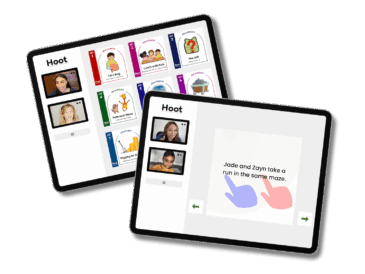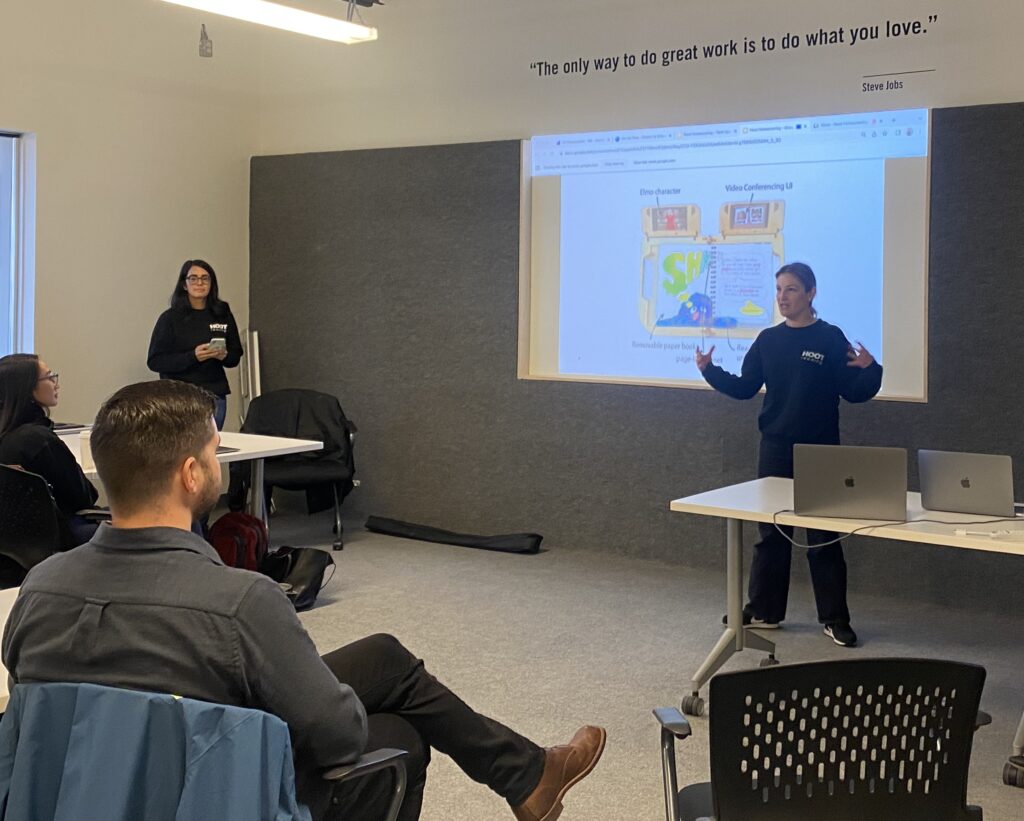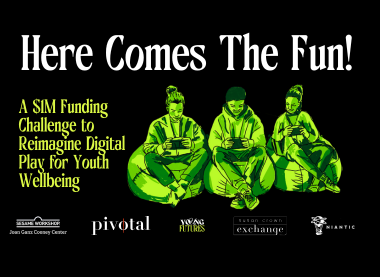For nearly two decades, edtech entrepreneur Carly Shuler has focused on how technology can best support and amplify the human connections at the heart of teaching and learning.

This mission drove her work as the Cooney Center’s inaugural fellow in 2007, and it remains central to her efforts as the Co-CEO and co-founder of Hoot Reading, a one-on-one online literacy tutoring platform enrolling thousands of students every year. Shuler shared a critical lesson she learned during her time at the Cooney Center that’s endured through the rapid changes in technology and her own evolving business model:
“You have to be very intentional when designing technology for children, because most of the technology that ends up in the hands of kids is not meant for human connection,” she said. “You can’t assume that it’s going to happen. You really have to build for it.”
Bridging Generations
Early in her career, Shuler was a brand manager at a major toy and children’s digital entertainment company. She left to pursue a master’s degree in education technology at Harvard’s Graduate School of Education and graduated the same year that Sesame Workshop established the Joan Ganz Cooney Center as an independent research and innovation lab for digital media.
“I felt like there was a big gap between the people making products for kids and the people who really understood child development, education, and psychology. I knew that Sesame was a leader in educating children through informal media,” said Shuler. “Working there really was my dream job.”
After a year-long fellowship at the Cooney Center, Shuler stayed four additional years on staff. One of the projects she worked on was Family Story Play, a collaboration between the Cooney Center and the research arm of the telecom company Nokia. Video calls were just going mainstream at the time, and the project team hoped they could use the technology to link grandparents with grandkids for shared reading time.
From a literacy standpoint, the goal was “dialogic reading”—the interactive, conversational mode of reading between adults and children that sparks engagement in stories and motivation to keep reading. Video calls could presumably give families more opportunities to benefit from this shared reading experience. However, it soon became apparent that behaviors that came naturally to grandparents and young kids reading together in person faltered when mediated by distance and a screen.
According to Miles Ludwig, former vice president of digital media for Sesame Workshop, neither grandparents nor early readers were the ideal demographic for video call interfaces, which were too technical and too abstract for the sustained engagement of dialogic reading.

“This work was really ahead of its time, because it recognized something we all learned during the pandemic, which was just how challenging video calls can be, especially with younger children,” Ludwig noted.
“Young kids are not going to just sit there and have a conversation with a grandparent. They’re going to hit that big red hangup button in 30 seconds,” said Shuler. “The challenge was to make this experience into something more interactive, less like a conversation and more like play.”
Their solution was Elmo. The beloved Sesame character would play the role of intermediary, sharing the screen with the humans in the Family Story Play product and scaffolding interactions by initiating the reading sessions, suggesting books, and modeling the playful reactions and questions about the unfolding story as the children and adults read together.
The prototype product was a tablet-like device that held physical books with a sensor keeping track of each page as they were read. According to a 2010 pilot study, both the quantity and quality of co-reading engagement improved with Family Story Play compared to co-reading sessions over a normal video call.
When Nokia closed its independent research arm in 2014, the company offered small grants to researchers who wanted to continue their projects. Tico Ballagas, a research scientist at Nokia who had been developing Family Story Play, convinced Shuler to co-found a company that would transform the physical product into an app called Kindoma (a mashup of the German words kind for kid and oma for grandmother).

Maintaining the human connection while going completely digital required yet another piece of intentional design—on-screen pointer fingers (color-coded for each reader) that kids and grandparents could move around as they read.
“You have to have that magic finger to point out specific words or objects on the screen,” said Shuler. “That shared touch is such an important part of the back and forth reading experience between adult and child”
While Kindoma was well received and used by tens of thousands of families, according to Shuler, “we were never able to crack the nut on the business model. We couldn’t make enough money from the app to raise proper venture capital.”
In 2016, Ballagas left the company for a new job, “and that left me with this incredible product but no clear idea what to do with it.”
Bridging Students and Teachers
The spark for Hoot Reading was lit over a lunch date between Shuler and her good friend, Maya Kotecha. Kotecha confided that her young daughter was having early difficulties with reading, and Shuler talked about Kindoma and the struggle to create a viable business targeting grandparents and parents.
“Together we decided, let’s try the app in a teaching and learning scenario,” Shuler recalled. Over the summer, they organized a pilot by connecting families in their network who wanted reading help for their kids with a couple of teachers they hired to tutor using the Kindoma app.
“I’ve never seen something that resonated so strongly, when it was really just a scrappy pilot,” said Shuler. “When the pilot ended, the parents were like, please keep it going.”

And so they did. Hoot Reading was born in 2018. Compared to fostering informal reading sessions with extended family members, connecting students with educators presented an entirely new challenge. The magic finger stayed in the new product, but the reading material had to change. Shuler and Kotecha needed to swap out the library of licensed storybooks with decodable books aligned with literacy standards.
“We couldn’t find high-quality decodables that were suitable for our needs and online use, so we wrote our own, more than 300 books that are used for our instruction,” said Shuler. They also needed to build the backend technology to automate the matching of students and tutors, scheduling sessions, and progress reporting.
“At first, we were scheduling kids with tutors on a whiteboard,” Shuler recalled. “Obviously, you can’t do that for very long. It’s not scalable.”
The need for effective virtual learning at scale came to the fore in early 2020 when schools closed at the height of the COVID pandemic, and in its aftermath when educators confronted widespread COVID learning loss. Studies have shown that one of the most effective interventions to mitigate COVID learning loss was “high-impact tutoring,” (HIT) which is typically defined as small groups of students (no more than four) who meet with a trained tutor at least three times a week. But intensive, in-person tutoring is expensive. There aren’t enough properly trained tutors, nor enough funding in most school districts to provide the service to anywhere near the number of students who need it. Many have looked to technology for help, including programs like Hoot Reading.

An early evaluation of Hoot by literacy specialist Dr. Susan Neuman, a professor of childhood and literacy education at New York University, found that adding twice weekly, 30-minute Hoot sessions to the in-person tutoring of a summer reading program boosted gains in word reading fluency by 86 percent and oral reading fluency by 152 percent. More recently, Hoot partnered with the National Student Support Accelerator at Stanford University, which conducted a randomized control trial of Hoot Reading during the 2024-25 school year, targeting 1,400 elementary school students in the Kansas City Public Schools who were reading below grade level. Early findings of the ongoing study show that Hoot students significantly outperformed control-group students on the I-Ready assessment, and that the effect size is larger for students who were designated as requiring Tier 3 intervention. Hoot students demonstrated both higher i-Ready typical growth scores than control-group students, as well as higher stretch growth scores than control-group students, meaning they are closer to achieving grade-level proficiency.
In addition to rigorous efficacy research, Hoot Reading has also earned the Tutoring Design Badge from the National Student Support Accelerator at Stanford University, demonstrating alignment with research-based program design practices. NSSA acknowledged that Hoot’s Tutoring Program excelled particularly in the areas of High-Quality Instructional Materials, Program Effectiveness, Tutor Selection, and Data Privacy.
One of the most significant developments for digital tutoring occurred in November 2022 when ChatGPT’s launch demonstrated the conversational prowess and lightning-fast knowledge retrieval of generative artificial intelligence. Both the hype and the headlines have since swirled around the potential for AI to tutor students directly. But Shuler and most experts in the field say the human connections between teachers and learners is too valuable to sacrifice. They say a far more effective use of AI is to support and expand the reach of human tutors, rather than replace them.
For instance, AI could be used to make personalized recommendations for the dosage of tutoring needed by different students instead of giving every student the same three sessions a week. The technology could also help review and analyze human tutoring sessions, to spot patterns where instruction is more or less effective.
“Quality assurance becomes so important, and increasingly difficult, as we scale,” said Shuler. “At Hoot, we’re not going to use an AI to tutor the student, but rather we will use AI to tutor the tutor and to tell us as an organization if there’s a teacher who needs more coaching.” AI works in the background, helping tutors assess exactly what a child needs to be working on and suggesting resources to address specific gaps in learning. “So instead of continuously assessing the student, the tutor is free to do what they do best,” Shuler said, “which is teaching and connecting with the students.”


